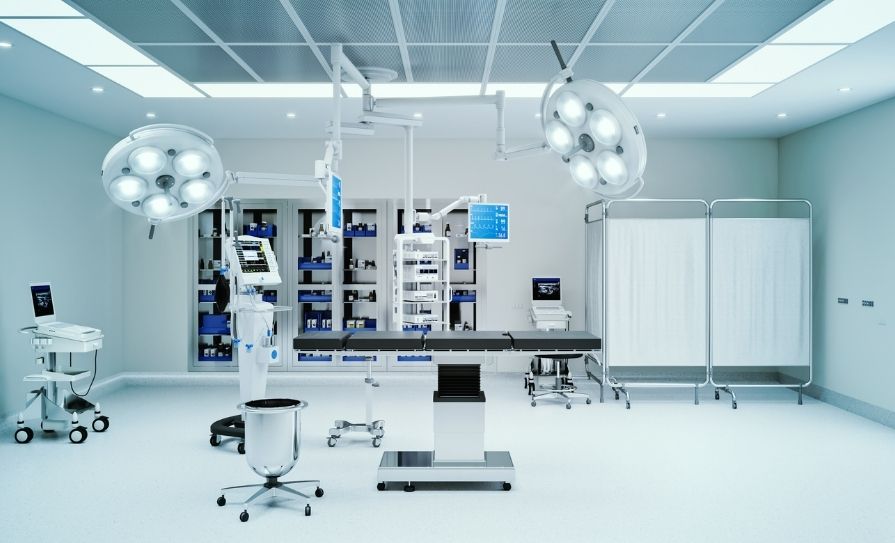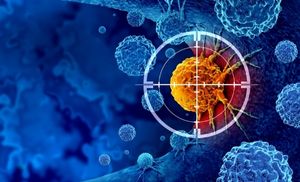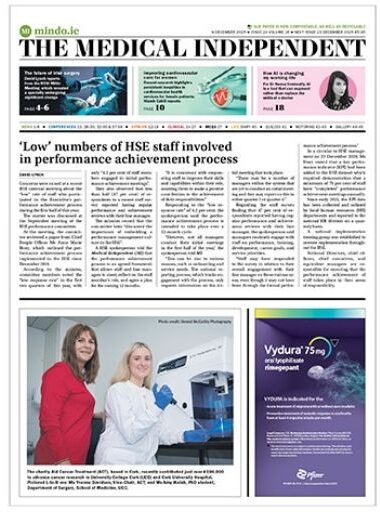Catherine Reilly examines the growing pressures in laboratory medicine and the potential solutions, with a special focus on histopathology
Science graduates with no qualifications or experience in laboratory medicine have been recruited to ‘medical scientist’ posts in some public diagnostic laboratories due to acute staff shortages, the Medical Independent (MI) has been informed.
Mr Kevin O’Boyle, Vice-Chair of the Medical Laboratory Scientists Association (MLSA), told MI the extent of this practice is not known, but it “is going on unfortunately”. The MLSA was due to meet with CORU to discuss the concerns. It is understood the HSE has also issued a communication relating to the matter.
‘Medical scientist’ is a legally protected title and practitioners must hold CORU registration.
Mr O’Boyle said CORU registration is “about patient safety” and “making sure the person that is employed is properly trained and educated”.
There is concern that ad-hoc titles, such as ‘histopathology technician’ or ‘laboratory scientist’, may have been used in some instances to ‘fill’ medical scientist posts amid the ongoing shortage.
A CORU spokesperson said it cannot comment on enforcement cases under investigation. “Misuse of a protected title is a rare occurrence, but it has happened and has led to criminal convictions. We encourage all employers to ensure that the medical scientists that are in their employment are fully registered by checking the medical scientists register on www.coru.ie.”
‘Severe staffing crisis’
A HSE review to inform the strategic direction of laboratory medicine, dated January 2024, stated: “In the face of increasing demand, and urgency in catching up on care delayed by Covid, laboratories are experiencing a severe staffing crisis with an unsustainable level of vacancies, which is already leading to reduced level of service, increased out-sourcing, and delayed turnaround times.”
In a nationwide survey conducted as part of this review, 68.9 per cent of laboratories reported that their staffing complement was ‘inappropriate for their department’s workflow’.
‘Inappropriate IT/automation’, ‘staffing’, and ‘space’ were identified as the three greatest challenges.
Some 61.3 per cent of laboratories reported an inability to meet local and/or national turnaround times (TATs). A number of urgent actions were recommended in this HSE review, including investment in ‘order communications systems’, and the expansion of medical laboratory aide numbers and roles (while maintaining an appropriate ratio of scientists to laboratory aides).
A HSE strategy for laboratory services from 2025 to 2029 is at an advanced stage of development.
Histopathology
Histopathology laboratories are among the diagnostic services under particular strain. Cancer incidence is increasing, and treatments are improving, including by means of targeted therapies. This has meant a growth in the variety and complexity of testing necessary to optimise patient care. In addition, the laboratory resource implications associated with HSE waiting list initiatives and cancer screening, for example, have gone largely unaddressed.
The annual reports of the RCPI histopathology quality improvement programme show that greater numbers of specimens are being submitted for individual patients and there are more blocks of tissue required for examination.
In 2022, the volume of cases increased by 6.3 per cent (or 30,480), according to the latest annual report, which included data from 21 public and seven private histopathology laboratories.
Specimens rose by 6.3 per cent (or 54,778) and blocks by 4.6 per cent (or 64,348) from 2021.
In the five years from 2018 to 2022, the number of all stains increased by 15 per cent and the number of immunohistochemical stains by 32.1 per cent.
This reflected the complexity of cases being reported and the increased need for now routine immunohistochemical assessment of various tumour types, in line with best practice guidelines.
The report found compliance with TAT targets was at an “all-time low” for surgical pathology specimens.
The TAT (time from receipt of specimen in laboratory to the authorisation of final report, calculated in working days) is a key measure of the overall function of a laboratory service. Due to the impact of TAT on the clinical management of patients, it is regarded as an important element of quality assurance.
The programme’s TAT target for ‘small biopsy’ is 80 per cent of cases completed in five days or less. In 2022, the national average for general centres was 61.7 per cent and for cancer centres it was 54.1 per cent.
In regard to non-biopsy cancer resections, the target is 80 per cent of cases completed by day seven or less. The national average for general centres was 59.1 per cent and for cancer centres it was 62.1 per cent.
There are two targets for GI endoscopic biopsy: 80 per cent of cases completed by day seven, and 100 per cent by day 10.
Seven out of the 17 general centres that provided data for this indicator met the first target; as well as two of the eight cancer centres.
The second target was not met by any general centres (seven sites achieved over 96 per cent of cases complete by day 10), or by any cancer centres.
In her foreword, Dr Ann Treacy, Chair of the national histopathology quality improvement (NHQI) programme working group, wrote: “To provide a high-quality service, laboratories require adequate resourcing and staffing. It is evident from this report, that there are ongoing pressures on turnaround times highlighting a vast issue in resourcing and recruitment with both scientist and medical staffing.
“This has been raised as a concern by the NHQI working group at the highest levels including the Faculty of Pathology, the National SQI [specialty quality improvement] Programmes Steering Committee and with senior HSE management.”
It is evident from this report, that there are ongoing pressures on turnaround times highlighting a vast issue in resourcing and recruitment with both scientist and medical staffing
Clinical programme data
Last year, data collected by the HSE National Clinical Programme for Pathology showed significant vacancies in approved posts at histopathology laboratories across the eight adult cancer centres.
This “benchmark” data was requested by the then HSE Director of Acute Operations, Prof Mary Day, in June 2023. According to emails obtained under Freedom of Information law, the data (on activity and staffing) was sought in the context of a business case for the histopathology laboratory at University Hospital Waterford (UHW), which serves hospitals and GPs in the south-east region.
In February 2023, a safety incident management team was established at UHW due to a large backlog in the reporting of ‘routine’ histopathology specimens. This backlog reportedly affected over 5,000 patients, with some waiting up to six months for results. Support was provided to clear the backlog, including overtime by consultants and medical scientists, engagement of additional agency medical scientists, and help from other laboratories, according to Ireland East Hospital Group. The Irish Examiner reported that retired pathologists also assisted.
The warning lights had been flashing for some time. Difficulties with TATs led to the UHW laboratory voluntarily suspending its ISO [International Organisation for Standardisation] 15189 accreditation status with the Irish National Accreditation Board (INAB) in early 2022. The histopathology laboratory at University Hospital Galway also voluntarily suspended its accreditation status for the same reason in 2023. As of May 2024, ISO 15189 accreditation status at the histopathology laboratories in Midland Regional Hospital, Tullamore; Connolly Hospital, Blanchardstown; and Our Lady of Lourdes Hospital, Drogheda, are also listed as voluntarily suspended on the INAB website. University Hospital Limerick opened a new histopathology laboratory in November 2023 and has committed to achieving accreditation.
In summer 2023, data submitted by the UHW laboratory showed most senior medical scientist posts were vacant (four of the seven posts). The majority of medical scientist posts were filled (13 of 14), as well as most of the consultant histopathologist posts (seven of nine). However, based on 2022 workload, UHW had the highest case numbers per pathologist, the second highest block numbers per pathologist, the fourth highest multidisciplinary team (MDT) meetings per pathologist, and the highest number of adult hospital/coronial post-mortems per (hospital-employed) pathologist, of the eight cancer centres.
UHW also ranked third in the number of cases/blocks per medical scientist and medical laboratory aide combined.
In an internal analysis, Mr Patrick Mulhare, Programme Manager of the HSE pathology clinical programme, underlined that “the pathologist numbers need to get to nine as soon as possible and then some more as laid out in business case”.
Mr Mulhare noted “a significant amount of senior medical scientist vacancies across the cancer centres which indicates a loss of experience, retention difficulties and competition for scarce staff”.
The whole-time equivalent (WTE) vacancies in the other histopathology laboratories included (but were not limited to): Five of the 13 consultant posts at the Mater Misericordiae University Hospital, Dublin; 5.5 of the 16.3 senior medical scientist posts at St Vincent’s University Hospital, Dublin; 9.51 of the 24.75 medical scientist posts at University Hospital Galway (which was “somewhat” offset by six agency staff), and 4.8 of its 12.6 senior medical scientist posts; 3.9 of the 14 medical scientist posts, and 2.3 of 11 senior medical scientist posts, at St James’s Hospital Dublin; and seven of the 23.5 consultant posts at Cork University Hospital. The chief medical scientist post at Beaumont Hospital, Dublin, was vacant, as were two of its 10.4 senior medical scientist posts.
In the Mater Hospital’s completed questionnaire, a chief medical scientist commented on un-resourced and under-resourced work, referencing essential quality improvement and accreditation-related activities. In addition, medical scientists had undertaken advanced training to perform histodissection for skin and breast pathology, but this provision had “not been resourced appropriately at any point”.
“The breast service requires two WTE histodissection scientists, but has only been resourced for 0.5 WTE (currently vacant) and the dermpath service requires one WTE scientist which has been resourced,” he wrote. “These are just three examples of where scientists have been removed from the day-to-day frontline service to facilitate other essential roles, without which the Cell Path service could not function appropriately.”
Furthermore, he stated “the downstream testing of patient samples has become far more specialised with the introduction of personalised medicine” and the lab was conducting “far more molecular testing” every year, with little or no additional resource. The chief medical scientist noted that one WTE medical scientist had been provided by the National Cancer Control Programme (NCCP) for PD-L1 testing.
Advanced practice
Entry to third-level medical science programmes in Ireland is competitive, with intake numbers limited by the availability of clinical placements. A modest recent increase in undergraduate places and the commencement of graduate-entry courses have been welcomed as initial steps. However, the HSE’s delay in launching a sponsored ‘trainee medical scientist programme’ has caused much dismay within laboratory medicine.
CORU has approved five educational programmes (recent intake figures indicate they can now deliver about 150 graduates per annum combined).
According to CORU, it is engaging with stakeholders to identify and support the development of new pathways to approved programmes.
MI understands that most graduates enter laboratory medicine. However, in the HSE there are limited higher promotional opportunities at scientific level, and an absence of (and under-utilisation of) grades that recognise advanced practice by medical scientists.
Over the years, cellular pathology has tended to attract comparably fewer graduates than other areas of practice. The reasons have been multifactorial, with limited on-call work a commonly cited factor.
However interest in cellular pathology is increasing, according to Ms Sinead Creagh, President of the Academy of Clinical Science and Laboratory Medicine (ACSLM), the professional body for medical scientists.
She said areas related to cellular pathology, such as advanced histodissection, perinatal pathology, molecular pathology, and implementation of digital pathology systems, are of significant professional interest to graduates.
“Our graduates [in medical science] are at such a high level,” said Ms Creagh. “I mean, with the amount of genetics and molecular work they do in college, they can now see there is an opportunity for that to be used if they do move into cellular pathology whereas that wouldn’t have been the case… definitely 10 years ago.… Things that were researched or cutting-edge five or 10 years are now custom and practice [in the large centres], things like molecular testing, next generation sequencing….
“You can be involved in the MDTs when the oncologists are there discussing patients because you are bringing the results you have generated this week on those patients. You can very easily see the direct impact that your work is having on that patient’s journey, and that is so fulfilling. Medical scientists are all highly qualified scientists; while we are not patient-facing we are committed to healthcare.”
However, Ms Creagh said “scientists need to be supported in being able to move into advanced practice roles”.
“We would like to see options for advanced practice in a much more formalised way within the HSE. At the moment… there is no advanced practice role on the [HSE] pay scales.”
The development of “extended roles” for medical scientists in areas such as macroscopic dissection was recommended in the national cancer strategy in 2017.
In response to the need for certified training in histopathological dissection, the School of Biological, Health, and Sports Sciences at TU Dublin, launched a level 9 CPD programme, which had its first intake in 2015. To date, the programme has graduated over 80 medical scientists (rising to 96 in June 2024).
This programme is delivered in partnership with the Faculty of Pathology, RCPI, and in collaboration with the ACSLM. It offers expert modules in pathological dissection of the specialised tissues; breast, skin, gynaecology, and gastro-intestinal tract.
It facilitates medical scientists to play an integral role in quality assured sampling for morphological, immunophenotyping, and molecular cancer diagnostics.
According to Ms Laura Clifford, Chair of the ACSLM’s cellular pathology advisory body, advanced histodissection involves “dissecting very complex cancer resection specimens, mastectomies, gynae specimens – these are very, very complex specimens that require a very high degree of training, so that very much is an area for an advanced practitioner”.
She said the formalisation of an advanced practitioner grade would benefit service provision, boost the number of medical scientists in cellular pathology, and recognise those who are already working in these highly specialised areas.
In a joint paper in 2016 (New Horizons), the ACSLM and MLSA stated there was “a real need to extend the role of a specific group of medical scientists to advanced practitioner and consultant medical scientist level”. These types of training pathways and roles are established in the NHS, for example.
All of this requires a synchronised and supported evolution of the workforce.
In 2021, a report by an ACSLM cellular pathology working group concluded that the supervised delegation of appropriate tasks to a non-medical scientist grade is a practical and achievable solution, which would overcome the acute medical scientist labour shortage and enable laboratories to achieve sustainable and quality focused cellular pathology services. In addition, this solution would increase the capacity of medical scientists to focus on advanced or more complex scientific tasks.
A Department of Health spokesperson told MI: “The Minister for Health is committed to working closely with the Department of Further and Higher Education, Research, Innovation and Science and the HSE to ensure that the conditions are in place to support further growth in healthcare professions, including increasing the supply of medical scientist graduates.”
They added: “A sponsored medical scientist training scheme continues to be under consideration by the Department of Health and the HSE. Funding for any such initiatives will be considered in the context of the 2025 Budget and Estimates process.”
The spokesperson also stated that the Minister and HSE are “committed to the development of medical scientist roles”.
Faculty of Pathology
Prof Mary Keogan, Dean of the Faculty of Pathology at RCPI, confirmed that the faculty actively supports the development of histodissection training.
However, given the “severe shortage” of medical scientists, it is “difficult to develop additional opportunities for advanced practice, until other staff can take on some of the work currently undertaken by medical scientists”.
She referred to the need to formally expand the role of medical laboratory aides.
“The Faculty of Pathology strongly supports expanding the role of medical laboratory aides through training and development of appropriate competencies. Such training is likely to be best delivered by medical scientists. Many tasks currently undertaken by medical scientists do not require a scientific degree and are performed by support staff in other countries.”
Pathologists are also in short supply nationally and internationally. A workforce report from HSE National Doctors Training and Planning in 2023 stated a current unmet demand of 25.5 WTE consultant histopathologists. A further 71.3 additional WTE were required to cater for the projected increased demand to 2035.
However, recent statistics show that intake to the higher specialist training (HST) programme in histopathology has been below its allocated posts.
The HST programme, which entails four-to-five years of training, had eight applicants for 11 available posts in 2023 and all were accepted on the programme. In 2024, there were 11 applicants for 14 available posts and 11 accepted offers (figures are subject to change until commencement in July 2024). Last year there were 72 applicants for basic specialist training in histopathology (a two-year programme) with 16 available posts and 16 offers accepted.
Digital pathology
One of the potential solutions to shortages of pathologists is the advancement of digital pathology systems.
Digital pathology is being adopted by many histopathology departments globally for diagnostic and educational work. It holds several potential benefits for patients, pathologists and other laboratory staff.
It enables electronic transfer of slides from the laboratory to the pathologist, enabling more rapid access to subspecialist reporting, for example.
Digital pathology would also allow histopathologists to be more flexible with their working practices, through use of remote interpretation, and this would further increase the attractiveness of the specialty.
However, while there has been exploratory work on digital pathology in Ireland, it has not been implemented as the routine service platform in any hospital to date.
Prof Keogan commented: “The full benefits of digital pathology will only be realised if a national approach is taken to the development of digital pathology. The Faculty of Pathology looks forward to contributing to the planning and development of digital pathology, which is fast becoming essential to train the next generation of histopathologists. The Laboratory E-health Programme and the Laboratory Services Reform Programme will play key roles in the development of this key infrastructure.”
Molecular provision and histopathology
Another area of rapid development is molecular pathology, which is now of crucial importance to decision-making on cancer care.
Prof Stephen Finn, Co-Director/Solid Tumour Lead at the Cancer Molecular Diagnostics (CMD) Laboratory at St James’s Hospital, Dublin, said molecular testing involving DNA/RNA extraction for cancer diagnostics is conducted at a small number of hospital laboratories nationally. The CMD laboratory at St James’s Hospital and the molecular pathology department at Beaumont Hospital are the two laboratories conducting this testing on a significant national scale. Under NCCP funding, St James’s and Beaumont provide testing for other hospitals to guide treatment decisions in regard to targeted therapies.
“Every histopathology department will need to have access to or perform their own molecular testing in the years ahead. For the very high-end molecular testing it will be ‘access to’,” said Prof Finn.
The CMD laboratory is very busy, and demand is growing annually, but 90 per cent of test results meet the TAT targets, said Prof Finn. Space is one of the most significant rate-limiting factors in terms of development. In addition, while praising the NCCP for its support, Prof Finn said funding for dedicated staff for assay development would allow the CMD laboratory to provide timely access to newer testing methods (eg, ctDNA).
He said Ireland requires a small number of highly specialised molecular diagnostic centres akin to the genomic hubs established in the NHS.
“There is a real need to take molecular diagnostics to the next level – to a very high level, with very large panels,” added Prof Finn. This will not only support oncologists in terms of treatment decisions, but also support histopathology departments in diagnosis. Prof Finn said the modern diagnosis of tumours sometimes requires molecular diagnostics beyond the scope of surrogate molecular methods such as immunohistochemistry.
HSE strategy
The coming period is vital for laboratory medicine with several initiatives in train.
The implementation of the long-delayed national laboratory information system (MedLIS) has commenced. The HSE strategy for laboratory medicine is nearing completion. This latter process is being led by the HSE Laboratory Services Reform Programme (incorporating the pathology clinical programme) whose Clinical Lead is Prof Martin Cormican and Scientific Lead is Ms Marie Culliton.
The strategy’s draft recommendations reflect many of the requirements raised in this article.
But the litmus test will be implementation – particularly for the most pressurised areas such as histopathology.
Delays in tumour subtyping results highlighted by ISMO President
The President of the Irish Society of Medical Oncology (ISMO) has said medical oncologists are experiencing delays in receiving the results of some tumour subtyping tests for their patients.
Speaking on the general experiences of medical oncologists, Prof Michaela Higgins told the Medical Independent routine processing of diagnostic specimens takes about a week, but further molecular subtyping of tumours, which may be done in-house or as ‘send-out’ tests, can take several further weeks.
“Medical oncology has evolved from the predominant use of non-specific cytotoxic chemotherapies to treat cancer, to the use of targeted or personalised treatments for the treatment of many cancers in Ireland,” she noted. “Key to the appropriate and most cost-effective use of these sophisticated medicines is the accurate identification of patients most likely to benefit from them and this often requires specialised biomarker assays to be performed on tumour samples.”
Prof Higgins said patients are sometimes dismayed at the perceived delay in receiving an appointment with medical oncology. However, the most appropriate treatment recommendation for a patient will be dependent on having good quality and complete tumour results available for consideration.
“To start a less effective treatment in the absence of completed pathology results may compromise patient care and impact both patient outcome and quality-of-life (for example, the use of chemotherapy for a non-small cell lung cancer if that tumour was subsequently found to have a mutation for which a targeted treatment is available).
“Another example of delays we are experiencing currently due to the lack of suitably qualified medical scientists is the turnaround time for HER2 FISH testing in breast cancer.
“National KPIs recommend the initiation of first cycle of chemotherapy within14 days of medical oncology appointment; however, the choice of treatment is different depending on whether or not the tumour cells over-express HER2. Patients receive relevant education on the planned systemic anti-cancer treatment they will receive before they start and may need additional work-up (eg, echocardiography) thus the lack of timely HER2 result can delay the
time to initiation of treatment.”
On occasion, there are some patients with cancer for whom treatment must begin while awaiting the delayed test findings.
“Particularly if they are unwell and the window of opportunity to treat (before they are too unwell to receive treatment) is closing,” stated Prof Higgins.
In regard to testing provision that oncologists would like to see more readily available for their patients, Prof Higgins stated: “Liquid biopsy techniques, such as use of ctDNA to identify somatic mutations in lung cancers, have been readily available in research settings for a decade, but are still not routinely available to Irish cancer patients. There is plenty of expertise within Irish hospital laboratories to perform these tests and they are far more acceptable to patients than further invasive biopsies. ISMO members would love to see them in day-to-day use with rapid turnaround times as soon as possible.”












Leave a Reply
You must be logged in to post a comment.